Salerno, Costiera amalfitana, Paestum
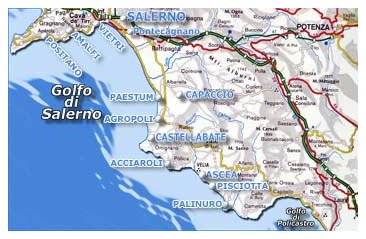
Short trip in the province
SALERNO
How wonderful to look upon, like Ulysses, on a clear day the Gulf of Salerno towards south-east, with as backdrop the high hazy coast and the crystalline mountains. One abandons the gods of today to discover a new self, lost, Mediterranean…
David H. Lawrence, 1920
Salerno is a fascinating synthesis of what the Mediterranean can offer to those who want to knowit better.
Its province is the largest of the Campania; it includes also the Amalfi Coast and the archaeological areas of Paestum.
From above, in the bright frame of sea and sky,Salerno seems as though it is hanging to the sides of the mountain, in a spectacular position on the gulf. The city became the most flourishing of southern Italy with its conquest by the Longobards in the 8th century, especially under Duke Arechi II.
Seat of the principality, Salerno entered a period of splendour, also becoming an important scientific centre with its much celebrated School of Medicine of Salerno, the oldest such institution in the west.
After the Longobards followed the Normans, and then the Hohenstaufen emperors, all of whom favoured the growth of the city, a growth that only ended in the 16th century when the Spaniards took over control.
It was in Salerno that the Allied forces disembarked in 1943.
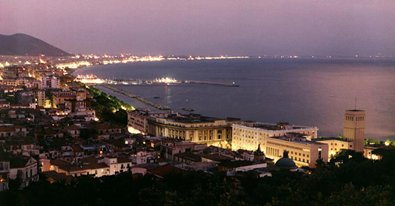
Today the city is in full rebirth, theatre of a transformation into ‘city-laboratory’, a model of urban revival of international importance.
The heart of the city is the medieval quarter, whose main artery is via dei Mercanti (Merchants’ street). The narrow city streets, today rich with shops, follow the form of the medieval urban plan and conserve beautiful historical buildings and much of its religious architecture.
The Dome (XI century)
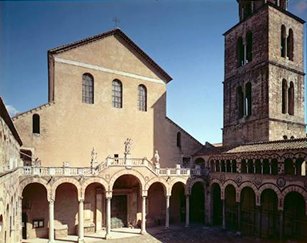 Built around 1080 by Robert Guiscard and dedicated to S. Matteo, whose mortal remains are preserved in the crypt, the Dome stands on a multi-layered area: on a early Christian Church built on the ruins of a Roman temple. During the centuries, it has been restored various times and the current appearance reflects the restoration of the Baroque area while, of the original Romanesque structure remain the decorations of the church, the bell tower and the atrium. The latter, surrounded by a portico supported by 28 columns with round arches, it preserves Roman and medieval mummy-cases and has, at its centre, a granite pool of the classic period. The basilica with a Latin cross plan and three naves, contains the ruins of frescoes, Roman finds and
XII century amboes decorated with sculptures and mosaics. The crypt that preserves the reliquaries of the Patron Saint of the city, are under the transept and the choir. It presents a structure with nine lines of three spans with cross vaults. In the XVII century, Domenico Fontana made important architectonic and decorative works by planning the vault of the crypt with diagonal
Built around 1080 by Robert Guiscard and dedicated to S. Matteo, whose mortal remains are preserved in the crypt, the Dome stands on a multi-layered area: on a early Christian Church built on the ruins of a Roman temple. During the centuries, it has been restored various times and the current appearance reflects the restoration of the Baroque area while, of the original Romanesque structure remain the decorations of the church, the bell tower and the atrium. The latter, surrounded by a portico supported by 28 columns with round arches, it preserves Roman and medieval mummy-cases and has, at its centre, a granite pool of the classic period. The basilica with a Latin cross plan and three naves, contains the ruins of frescoes, Roman finds and
XII century amboes decorated with sculptures and mosaics. The crypt that preserves the reliquaries of the Patron Saint of the city, are under the transept and the choir. It presents a structure with nine lines of three spans with cross vaults. In the XVII century, Domenico Fontana made important architectonic and decorative works by planning the vault of the crypt with diagonal
panels, alternated with circular ones, and delimitated with stuccoes and frescoes. Very interesting is the concept of the double altar of S. Matteo, whose bifront statue allowed the celebration of two masses.
The nearby Provincial Archaeological Museum is not to be missed, housed in the complex of Saint Benedict, it is one of the most interesting topographical museums of Campania.
The hub of economic life of the city is to be found in the 1800’s quarter of the city near to the Lungomare Trieste, one of the longest waterfront in Italy, lined by palm trees, and from which you can enjoy a lovely view of the gulf.
The Verdi Theatre was inaugurated in 1872. Its halls overflow with Renaissance-inspired décor and follow models of ancient classic inspiration. It is the cultural centre of the city. The Villa Comunale (City Park) is an oasis of green, a lovely public garden. Looking up towards the hills you can see the imposing Arechi’s Castle, from which there is an enchanting panorama.
Arechi castle
 The castle, situted on the Bonadies Mountain overlooking the city, is named after the Longobard leader Arechi II, who in the VIII century built the great denfensive system of which the castle is part of. The fortress was never conquered, even if Gisulf II, the last Longobard prince of Salerno, surrender in front of the Normans after a very long state of siege. After the castle had ups and downs, until the defense systems were changed in the XVII century, and, in the end, its decline started. After the restoration the museum of the Arechi castle was opened to the public and new rooms for exhibitions, conferences and conventions were created.
The castle, situted on the Bonadies Mountain overlooking the city, is named after the Longobard leader Arechi II, who in the VIII century built the great denfensive system of which the castle is part of. The fortress was never conquered, even if Gisulf II, the last Longobard prince of Salerno, surrender in front of the Normans after a very long state of siege. After the castle had ups and downs, until the defense systems were changed in the XVII century, and, in the end, its decline started. After the restoration the museum of the Arechi castle was opened to the public and new rooms for exhibitions, conferences and conventions were created.

THE AMALFI COAST
The Day of Judgement, for those amalfitans that go
to heaven, will be a day like any other
Renato Fulcini, 1878
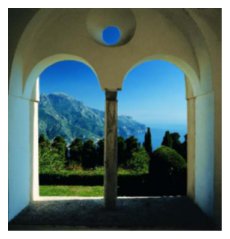
The incomparable beauty of the Amalfi Coast has enchanted visitors from all corners of the earth. Thelush green terraces, suspended over a sparkling sea, the wealth of art and the architectural characteristics, make it one of the most celebrated places on earth. Wild, daring and romantic, the Coast is an obligatory stop in any journey to Italy. From a geographic point of view the “coast of the Sirens” is the southern slope of the Sorrentine Peninsula, which in the north closes the Gulf of Salerno. The scenery is characterised by mighty cliffs that drop into the sea, rich with bays and coves like the splendid Emerald Grotto at Conca dei Marini and the Fiordo (Fjord) di Furore. Amidst vertiginous slopes, sheer drops and precipitous cliffs, there are places where nature is still uncontaminated, like the Vallone di Porto Oasis. The little villages that dot the “divine coast” are all to be explored, enjoying a clear blue sea, the stupefying views, the artistic treasures and the lively high society life. Shopping is also a venerated activity: in the characteristic boutiques of “Positano Fashion”, the ceramic shops of Vietri or sampling a delicious meal of traditional cuisine.
VIETRI SUL MARE
“I have never seen more gracious places. The first you find is Maiori…The solitary streets and tranquil trails enter into the mountain, from which clear and fresh waters spring. So much romantic solitude restores one’s soul and gives birth to the desire to live there in peace, or at least spend a summer.”
Ferdinand Gregorovius, 1861
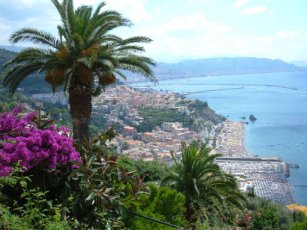
At the base of the Amalfi Coast, on the side facing the Gulf of Salerno, Vietri sul Mare dominates from the small Valle di Bonea above, erected on the bastions of limestone and sloping down to the coast. With its small churches, their majolicacovered domes, and the small tile-covered houses, Vietri seems suspended between heaven and earth. In ancient times the town was Etruscan, but it was later dominated by the Samnites, the Lucanians and finally by the Romans. The church of San Giovanni Battista (St John the Baptist), dating to the 17th century, with its majestic dome and high bell tower, is located at the highest point of the old centre of town. The ceramics industry, for which Vietri is world famous, was already a booming business in the Middle Ages. Over the centuries artisans and artists have created prized works, a part of which can be admired in the Ceramics Museum which is located in the belvedere-tower of the Villa Guariglia in Raito.
The Ceramics of Vietri

The advantageous position of the town, the ample supply of water and the richly wooded hills are all elements which over the years have lead to the development of the factories. The ceramics of Vietri, small masterpieces, are decorated with yellow and blue, the colours of nature and the sea, and with lemons and trusses of grapes. It is a pleasure to stroll about, to browse in the shops, visit the factories, and let your imagination be caught up in the whirlwind of colours and ideas. The choice is practically infinite and each shop differs in style and design.
Just before Vietri is Cetara. This has always been a
fisherman’s village and its name comes from the
latin word ‘cetaria’, or tuna fishing net. This village
with its picturesque white architecture and its
intimate beach is one of the jewels of the coast. In
between the little square houses the church of San
Pietro stands out with its majolica cupola and its
bell tower from the 13th century.
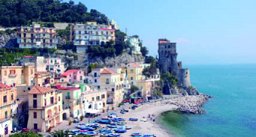
The straining of anchovies in Cetara
Cetara is known to gourmets for this ‘distilled’ dish, obtained by a special process of the salting of the anchovy caught in the gulf of Salerno. The straining seems to be a noble descendant of the ‘garum’, the ancient fish sauce used by the Romans for flavouring their dishes. The precious liquid was obtained by pressing anchovies.
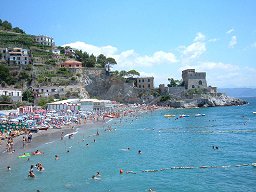
A few kilometres from Maiori is Erchie, with a tower on a boulder which separates the two beaches. The benedictine monastery Santa Maria de Erchie, founded in 980 and destroyed in 1451, gave this place its name. This small village with the characteristically white houses, the delightful beaches and the crystaline sea is ideal for a moment
MAIORI
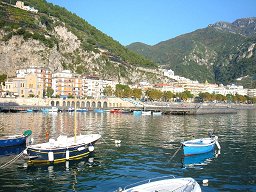 With is long beach and lovely shoreline, Maiori boasts the best hotels of the area. Ruins of castles and towers give testimony to its medieval splendour, when it was encircled and defended by walls and fortifications. The church of Santa Maria a Mare dominates the town, and on every year on August 15 festivities commemorate an event dating to 1204, when fishermen pulled a statue of the Virgin from the water after it had been dumped by a boat from Constantinople that was in trouble and had sought refuge in the Maiori bay during a tempest. On the main altar there is a wooden sculpture of the Madonna and Child, and a collection of art is cared for in the Sacristy Museum and the crypt below it. The popular sanctuary dedicated to the Madonna delle Grazie has medieval origins, but was restructured in the 1700’s. The unusual stone complex of Santa Maria Olearia, a benedictan abbey built around the year 1000 is worth a visit. In the buildings that hug the rock cliff, in one of the natural grottoes of the area, there are halls, chapels, and small frescoed porticos. A boat trip will take you for a visit to the Grotta Sulfurea and the Grotta Pandora. The first one is rich in sulfuric-magnesic water with therapeutic properties; in the second one the emerald-green scene, the stalactites and stalagmites create an unforgettable scenario. Also around Minori one can find many signs of the past, a lovely seaside resort as well as a grand Roman villa.
With is long beach and lovely shoreline, Maiori boasts the best hotels of the area. Ruins of castles and towers give testimony to its medieval splendour, when it was encircled and defended by walls and fortifications. The church of Santa Maria a Mare dominates the town, and on every year on August 15 festivities commemorate an event dating to 1204, when fishermen pulled a statue of the Virgin from the water after it had been dumped by a boat from Constantinople that was in trouble and had sought refuge in the Maiori bay during a tempest. On the main altar there is a wooden sculpture of the Madonna and Child, and a collection of art is cared for in the Sacristy Museum and the crypt below it. The popular sanctuary dedicated to the Madonna delle Grazie has medieval origins, but was restructured in the 1700’s. The unusual stone complex of Santa Maria Olearia, a benedictan abbey built around the year 1000 is worth a visit. In the buildings that hug the rock cliff, in one of the natural grottoes of the area, there are halls, chapels, and small frescoed porticos. A boat trip will take you for a visit to the Grotta Sulfurea and the Grotta Pandora. The first one is rich in sulfuric-magnesic water with therapeutic properties; in the second one the emerald-green scene, the stalactites and stalagmites create an unforgettable scenario. Also around Minori one can find many signs of the past, a lovely seaside resort as well as a grand Roman villa.
MINORI
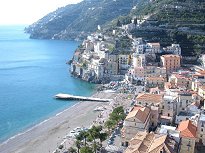 A charming seaside village, Minori, with its little pink houses over the beach, also offers splendid scenery. For its lovely position along the coast, it was where the ancient Romans dedicated themselves to relax, as witnessed by the many ruins, amongst which the Villa Romana, from the 1st century BC, a 2,500 sq mt archaeological complex containing a viridarium (garden), a nymphaeum-triclinium, and the splendid mosaics. At the Antiquarium Museum there are relics dating back to the 1st century BC. In the centre of the village, near to the little port, is the Basilica of Santa Trofimena, patron of the city, built in the 12th century. Many other little churches and towers dot the area.
A charming seaside village, Minori, with its little pink houses over the beach, also offers splendid scenery. For its lovely position along the coast, it was where the ancient Romans dedicated themselves to relax, as witnessed by the many ruins, amongst which the Villa Romana, from the 1st century BC, a 2,500 sq mt archaeological complex containing a viridarium (garden), a nymphaeum-triclinium, and the splendid mosaics. At the Antiquarium Museum there are relics dating back to the 1st century BC. In the centre of the village, near to the little port, is the Basilica of Santa Trofimena, patron of the city, built in the 12th century. Many other little churches and towers dot the area.
RAVELLO
“close to Salerno is a coast looking out at sea, called by the locals the coast
of Amalfi, covered with little towns, gardens and fountains, and men rich and
profitable in the art of trade and other.
Amongst the towns there is one called Ravello.”
Giovanni Boccaccio, 1351
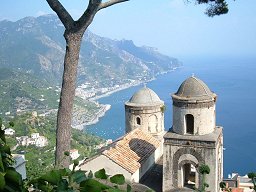
One of the gems of the Amalfi coast is Ravello, 350 meters above sea level, where the light effects and magical architecture create a vision of rare intensity. Its name is immortalized in Boccaccio’s Decameron. Famous for its tranquil and serene atmosphere, Ravello offers architectural gems of rare elegance. The 11th century Duomo, dedicated to San Pantaleone, is rich with artistic treasures like the grand bronze central door adorned with 54 panels.
To the right of the Cathedral a square tower marks the entrance to Villa Rufolo. Immersed in a verdant park of exotic and mediterranean flora, the original structure dates back to the 13th century; and even today some of its arab-siculian architecture is evident. The polychromatic arabesque colonnade is splendid. The garden is one of the most beautiful in Campania. Nature and man’s touch compete to create a highly evocative atmosphere: villas lined by lime trees and cypresses, cascades of flowers. From the belvedere the sea seems infinite. Each summer, in the gardens of the villa, the concerts of the Ravello Festival are held. Wagner’s inspiration for the Klingsor Garden, in his opera Parsifal, came from the gardens of Villa Rufolo.Villa Cimbrone was, originally, a simple hut. It was bought in 1904 by Ernest William Beckett, who transformed into an exceptionally fascinating Villa.
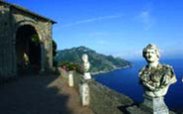 It has hosted many celebrated personalities, from Winston Churchill to Greta Garbo. There is a very special feeling in the cloister of the villa, still showing elements of the ancient arab-sicilian style it was built in. The belvedere is a terrace that gives on to infinity, and has no equal in the world. San Giovanni del Toro and Santa Maria a Gradillo churches, both built in the 12th century, also merit a visit. The San Giovanni del Toro church has a pulpit rich in mosaic decorations. The Coral Museum, which exhibits coral, cameos, decorated mother-of-pearl and shells from Roman times to the 1900’s, is also interesting. Scala is close to Ravello, one of the most picturesque site of the coast. Its Cathedral has a wooden Deposition from the Cross dating back to the 1200’s.
It has hosted many celebrated personalities, from Winston Churchill to Greta Garbo. There is a very special feeling in the cloister of the villa, still showing elements of the ancient arab-sicilian style it was built in. The belvedere is a terrace that gives on to infinity, and has no equal in the world. San Giovanni del Toro and Santa Maria a Gradillo churches, both built in the 12th century, also merit a visit. The San Giovanni del Toro church has a pulpit rich in mosaic decorations. The Coral Museum, which exhibits coral, cameos, decorated mother-of-pearl and shells from Roman times to the 1900’s, is also interesting. Scala is close to Ravello, one of the most picturesque site of the coast. Its Cathedral has a wooden Deposition from the Cross dating back to the 1200’s.
ARTISTS IN RAVELLO
Other than Wagner, musicians, writers and artists have found in Ravello their artistic inspiration: the inventions of Grieg’s Peer Gynt owe much to the woods of Ravello. Toscanini, Leonard Bernstein, Rostropovich, and Bruno Walter also spend relaxing time here. Mirò, Escher, Turner, whose seascapes of the area are to be found in London’s Tate Gallery, as well as the writer and art critic Ruskin, were also guests here. Forster, author of Room with a View, describes parts of the town; David Herbert Lawrence wrote many chapters of Lady Chatterley’s Lover here, and Andrè Gide set part of his novel The Immoralist here. Many more came here to enjoy the unique beauty, others settled here for good: Virginia Woolf, Paul Valéry, Graham Greene, Tennessee Williams, Rafael Alberti and Gore Vidal.
FROM AMALFI TO POSITANO
The aerial precipice of Amalfi is immersed in a network of pure colours that does not repeat the nauseating and lazy colours of certain famous tropical seasons along the route of the great journeys.
Here is the garden that we are eternally and uselessly searching for, after the perfect places of our childhood.Salvatore Quasimodo, 1966
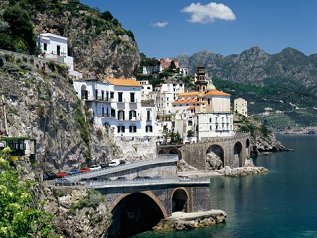 ATRANI
ATRANI
Almost tied to Amalfi, preserves in the intricacy of its little streets, stairs and overpasses, its medieval texture. During the Republican era of Amalfi, Atrani was inhabited by noble families. Here Doges were crowned and buried.
Between alleys, arches, courtyards, little squares and with its typical small stairways, it seems like a nativity licked by the sea.
Atrani faces the sea with the characteristic profile of the Maddalena Church (1274) that is topped by a belltower and cupola that is covered with vividly coloured majolica. The neoclassic church of San Salvatore de’ Bireto, on piazza Umberto I was
founded in 940. It was in this church that the election ceremonies and inaugurations of the new Doges of the Republic were held.
The Grotto of the Saints can be reached by the state road. Here the ruins of the ancient Benedictine monastery of Santi Quirico e Giulitta, founded in 986, are visible. The little grotto is decorated with byzantine style frescoes that date to the 12th century.
 AMALFI
AMALFI
The heart and soul of the coast is Amalfi. In the serene blue of the sky and sea,
Amalfi, guarded by its port, seems held in the palm of a hand. Above, the scenic drapery of the mountains, hinged like a backdrop, dotted with houses; below, a picturesque weaving of alleys and steps, all the way to the Piazza, where the Cathedral dominates from the top of its majestic stairs. A unique scene, where historic memory intertwines with unforgettable natural beauty. Suspended between the slopes of Lattari Mountains and the sea, the picturesque alleys of Amalfi today host a large number of tourists, but there was a time, when the powerful Marine Republic had its moment of maximum splendor between the 10th and 12th centuries, that they kept the outsiders (Longobards and Saracenes) at bay.
Rich and populated Amalfi enjoyed lively contact with the Orient. In memory of its ancient power every four years, in June, Amalfi holds the “Historic Regatta of the Marine Republics”.
 The town of Amalfi, clinging to the slopes of the coast, is characterised by the
The town of Amalfi, clinging to the slopes of the coast, is characterised by the
famous Duomo (9th century). Its scenic position at the top of steep stairs, that open up among the houses gathered around the small square, give a particular flavour to
Amalfi’s historic centre.
The imposing polychromatic façade of the church, illuminated by gilded and enameled mosaics, is impressive. Traces of the middle ages are to be found in the elegant Cloister of Heaven, with its arabesque lines. From the cloister go to the Crucifiction Chapel, where the Diocesan Museum is hosted. In this chapel is the entrance to the crypt, dating back to the 1200’s. The complex is one of the best examples of Romanesque architecture of the Amalfi coast. An exploration of Amalfi that desires the inclusion of the less known places should make a stop at the Antichi Arsenali, where famous galleys, with over one hundred oars, were constructed and destined to commerce with the Orient. The Tabula Amalphitana is preserved in Palazzo Morelli, seat of the municipality and of the Civic Museum. It was the first code of naval law, established in the times of the Republic and valid for the entire Mediterranean Sea. The famous “drafts” of Domenico Morelli, one of the most famous painters of the 1800’s, from which the mosaics which adorn the church were created, can be admired.
 Amalfi is also famous as the home of handmade paper.
The first workshops were opened along the Valley of the Mills, where the Paper Museum is. This area, crossed by the Canneto River, and that of the nearby Valley of the Ferriere, a charming natural environment, constitute a Natural Biogenetic Reserve. The ascent from Amalfi is tiring but fascinating. The remains of the mills that brought the water to the paper workshops are discovered, and the walk in nature that hides secret charms, is rewarded with springs and waterfalls, and glimpses of the sea between the lush mediterranean scrub.
Amalfi is also famous as the home of handmade paper.
The first workshops were opened along the Valley of the Mills, where the Paper Museum is. This area, crossed by the Canneto River, and that of the nearby Valley of the Ferriere, a charming natural environment, constitute a Natural Biogenetic Reserve. The ascent from Amalfi is tiring but fascinating. The remains of the mills that brought the water to the paper workshops are discovered, and the walk in nature that hides secret charms, is rewarded with springs and waterfalls, and glimpses of the sea between the lush mediterranean scrub.
The stairs of the Coast
What would the Amalfi Coast be without its stairs? They are everywhere: a characteristic of its villages, agile and indispensible communication system to overcome impervious height differences. It does not take long to become accustomed to them, one soon learns to appreciate its picturesque and, above all, ecological aspect, useful also in disintoxication from stress and city noise.
The Wine Trail of the Amalfi Coast
The Road twists amidst terraces that hold hanging vineyards on precipices over the sea, suddenly opening with marvelous views, between the valleys and gorges where the splendid architecture of the coast clambers upwards.
The traditional vines are cultivated here, and are renamed by the locals, like Falanghina, become Bianca Zita (white girl); Biancolella, become Bianca Tenera (tender white) and Lo Sciascinoso, Olivella.
The wines produced are all Costa d’Amalfi and Ravello Doc wines.
Amalfi paper
There is no documentation about the origins of paper production. In 1220 Frederick II, however, prohibited the notaries of the kingdom, especially those from Amalfi, from using “bambagina” paper (as it was then called) for the writing of Acts, because it was considered more perishable than parchment.
None the less, its spread could not be arrested, and the art of paper-making was diffused all over the Coast, especially after the Council of Trent decreed the obligation of recording all the sacramental acts, deaths and religious events. In the 15th century the fame of Amalfi paper was such that many foreign authors demanded to be published in Naples to be able to use the prized material. Even today, in a reduced manner, the paper-makers of Amalfi, the oldest in Europe, still
handmake the precious paper for use by artists or limited edition
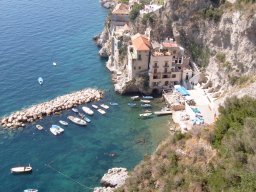
CONCA DEI MARINI
The nearby Conca dei Marini is a fishing village hemmed in by a marine loop that offers a stunning slice of panorama. The two extremes of this marvellous bay are Capo di Conca, dominated by the Torre di Conca (erected in the 1500’s) testimony
to the terrifying incursions of pirates, and the Emerald Grotto.
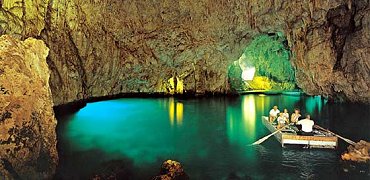 The waters breaking into the grotto take on an intense green hue, caused by light filtration. This grotto is full of stalactites and stalagmites, often fused together to form limestone columns of up to 10 meters.
The waters breaking into the grotto take on an intense green hue, caused by light filtration. This grotto is full of stalactites and stalagmites, often fused together to form limestone columns of up to 10 meters.
From Conca you can get to the plateau of Agerola (650 mt), passing through woods and fields. The area, blessed with flowering fields renown since antiquity, is famous for its dairy products and for the exceptional views of the coast from above.
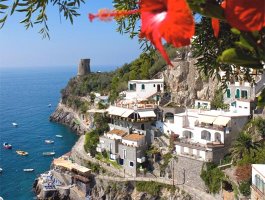 PRAIANO
PRAIANO
halfway up the promontory of Capo Sottile, was the summer residence of the Doge of Amalfi, a precocious sign of the future of the village toward becoming a relaxing holiday resort. The lower part of town goes towards Marina di Praia, a beach carved between two high rock walls. Guarding over this marina is one of the many watch-towers that dot the coast.
The “votive kiosks” of Praiano
There are many “votive kiosks”, tiny chapels of majolica tiles or with frescoed walls, spread around Praiano. They are spontaneous testimony to popular devotion, placed on walls of houses or on the
borders between properties, they begged for divine protection.

FURORE
On a slope cultivated with vines and olive trees one finds Furore. The ancient name for the entire area was once Terra Furoris, for the deafening noise made by the sea and the wind during tempestuous nights as they echoed among the high walls of the
sheer fjords that come straight down from the plateau of Agerola. A steep set of steps takes you to the bottom. The attraction of this piece of coast is irresistable, with the fjords wedged between vines and cliffs, tiny houses and the sea.
POSITANO
Positano bites deep. It is a dream place that isn’t quite real when you are there
and becomes beckoningly real after you have gone.
Its houses climb a hill so steep it would be a cliff except that stairs are cut in it.
The small curving bay of unbelievably blue and green water lips gently on a beach of small pebbles.
John Steinbeck, 1953
 Set into the mountain, surrounded by rich mediterranean vegetation, Positano is so
Set into the mountain, surrounded by rich mediterranean vegetation, Positano is so
picturesque as to seem a spontaneous stage setting. Seen from the sea it looks like a huge nativity scene, a waterfall of little multicoloured houses clingin onto its sides.
The town develops vertically. The homes, one on top of the other, are characterised by arched porticos that give onto the sea, and are painted in pastel colours, giving it the look of a multifaceted preciousstone. It is not for nothing that Positano is called
“the gem of the divine coast”.
The narrow streets, lined with boutiques, run downhill between the houses flowing onto the Spiaggia Grande, a wide beach. From here there is a beautiful view of the sea, as well as of the town as it clambers up the mountainside.
On the main square of Positano is the parish church of Santa Maria Assunta, there since the year 1,000. The great coloured majolica cupola is visible from all over town. The little beaches of Positano are charming, and easy to get to on foot or by boat: Fornillo, Fiumicello and Arienzo.
Positano is a holiday destination appreciated for VIP vacations. Around 1940 Irene Kowaliska, a painter who lived here in Villa Sette Santi, used Positano
as inspiration for her paintings on cloth.
The Villa Stella Romana has been host to, among other Popes, Pope John Paul II. Illustrious artists, fashion moguls and screen stars love to come here to relax.
A few miles from the coast are Li Galli, or “Sirenuse”, a tiny archipelago made up of three islets: the Gallo Lungo, the Rotonda and the Castelluccio, considered the ancient dwellings of the enchanting Sirens. Positano is not just about the sea: pleasant walks take one to visit the evocative areas around Lattari Mountains, like
Montepertuso, so-called because it is said that the Madonna appeared here in a hole in the cliff (“pertuso” stands for hole) . A stairway of 1,700 steps takes you to Nocelle. It is from here that the famous Trail of the Gods (Sentiero degli Dei)
begins, with beautiful views over the entire coast.
Or you can reach the beautiful coastal Punta San Pietro, where there is a little church on a precipice over the sea.

Shopping in Positano
Positano is synonymous with summer fashion. In the labyrinth of alleys the miracle of “made in Positano” fashion was realised: dozens of boutiques show off their whimsical summer-wear, by now known the world over.
Textiles and colours lay down the law in the world of beachwear: pareus to bikinis, casual and “gran gala” evening wear, even characteristic wedding dresses. The hand-made leather footwear can be ordered to size.
On sale are the colourful local ceramics, the paintings by the many artists that propose views of the enchanting gulf, and a wide range of typical products.
The myth of the Sirens
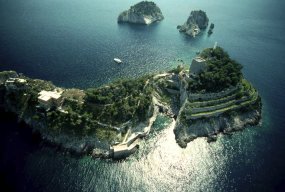 The Sirenuse archipelago (now known as Li Galli) in front of Positano, three solitary rocky islets, were considered to be the dwellings of the Sirens, mythical figures that attracted seafarers with their chants, often causing them to wreck. The myths probably served as warnings: the islets were meant to be a reference point for the sailors, if they got too close to land they would end up on the rocks. In 1924, on the islet of Gallo Lungo, the Russian dancer and coreographer Leonide Massine built a villa (restructered in 1927 by the architect Le Corbusier) that was eventually bought by Rudolf Nureyev. In memory of these artists the Positano International Award for the Art of Dance is presented every year.
The Sirenuse archipelago (now known as Li Galli) in front of Positano, three solitary rocky islets, were considered to be the dwellings of the Sirens, mythical figures that attracted seafarers with their chants, often causing them to wreck. The myths probably served as warnings: the islets were meant to be a reference point for the sailors, if they got too close to land they would end up on the rocks. In 1924, on the islet of Gallo Lungo, the Russian dancer and coreographer Leonide Massine built a villa (restructered in 1927 by the architect Le Corbusier) that was eventually bought by Rudolf Nureyev. In memory of these artists the Positano International Award for the Art of Dance is presented every year.

PAESTUM

At the edge of the Sele plains, where Cilento begins, is Paestum. It is one of the most precious of the archaeological gems of Italy, known the world over, especially for its spectacular doric temples.
Legend attributes them to the Argonauts of Greek mythology, but it was the inhabitants of Sibari that founded Paestum in the 6th century BC. The city, first called Poseidonia, soon became one of the most flourishing of the Mediterranean. Its demise coincided with the fall of the Roman Empire. The buildings were stripped for the construction of churches and palaces, and the ruins forgotten until the 18th century, when travellers began to return here.
The three doric temples from the 5th century BC, among the best preserved of all of antiquity, are the marvels of this Archaeological Park, as they stand majestically on the plains in front of the sea: the Temple of Neptune, the Basilica and the Temple of Cerere. The first two are tied to the cult of Hera (Greek goddess of marriage and wife of Zeus). The 5 km long walls constitute one of the best preserved fortified structures in all of Magna Grecia. In summer the ‘Night trails’ amid the temples of Paestum permit the visitor to enjoy the archaeological area by moonlight, a magical experience.
In the area of the Roman city, apart from the Capitolium, there are other significant remains: the Forum, the Amphitheatre, and the remains of various religious structures. To the west of the temples is via Sacra, the street of the processions, the foundations of which are Greek.
 Not far from the excavations is the Archaeological Museum of Paestum, home to some of the most important works in Southern Italy. The most important are the frescoes from the 5th century BC Tomb of the Diver.
Not far from the excavations is the Archaeological Museum of Paestum, home to some of the most important works in Southern Italy. The most important are the frescoes from the 5th century BC Tomb of the Diver.
It is a “painted box tomb”, made up of four lateral slabs decorated with banquet scenes. The cover depicts a diving boy: the scene probably symbolises the passage from life to the world of the dead. The sculptured metopes are important decorative elements of the temples, as are the frescoes of the 4th century lucanian tombs, with the typical“Return of the warrior” scenes.
The Aeneolithic relics of the Gaudo necropolis are preserved here, as well as archaic, (the terracotta Zeus statue), classic and hellenistic (the bronze statue of Sileno Marsia) era items. In the museum the full room tomb of a man and a woman from Agropoli has been reconstructed. With the buried couple there is also a famous vase on which the myth of Bellerophon is painted, signed by Assteas. The relics of the nearby sanctuary of Hera Argiva, the Heraion of Sele, are also kept here.
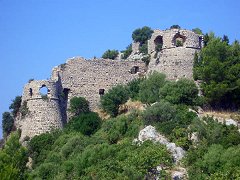
The ruins of Capaccio Vecchio dominate the plain of Paestum. The town, flourishing in the Norman era, was destroyed in 1248 by Frederick II because it hosted conspirators. Apart from the ruins of the castle, the sanctuary of the Madonna del Granato, built in the 12th century and reconstructed in the 1700’s, destination of intense pilgrimage even today, is well worth a visit.

Buffalo mozzarella
The exquisite buffalo mozzarella is made only in Campania, and following unchanged centuries-old
traditions. Apart from the Caserta province, the Sele Plains are the only other place for this characteristic product. There are many dairy farms in the area of the mouth of the Sele river: in some it is possible to watch them make it and then enjoy the fresh results.
- Torna al sommario degli Eventi -